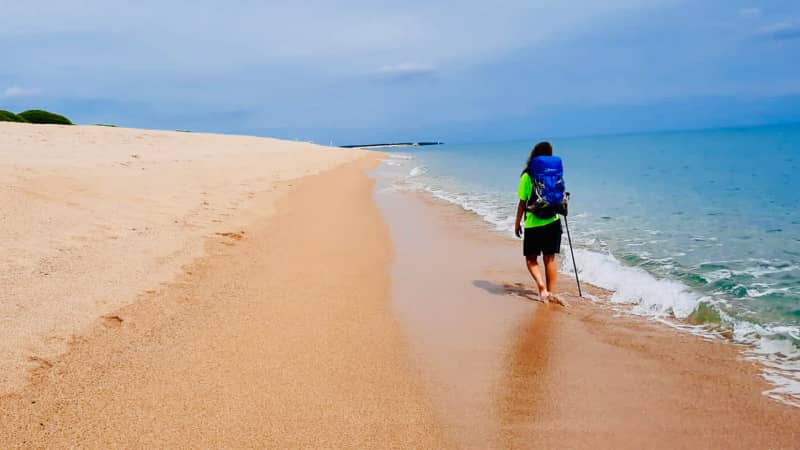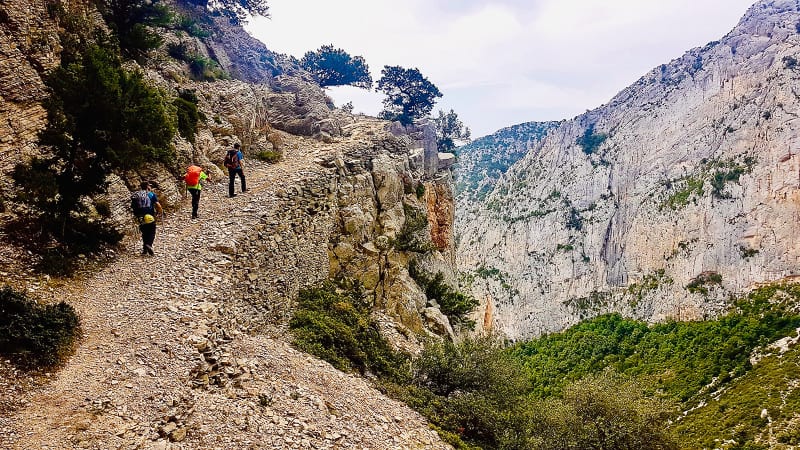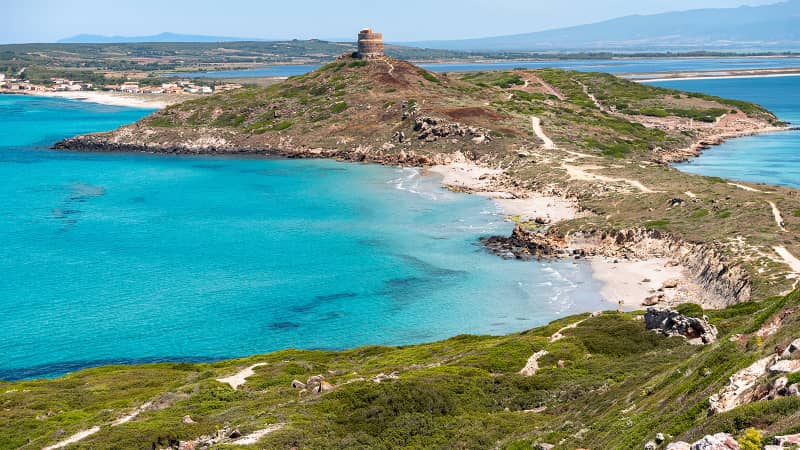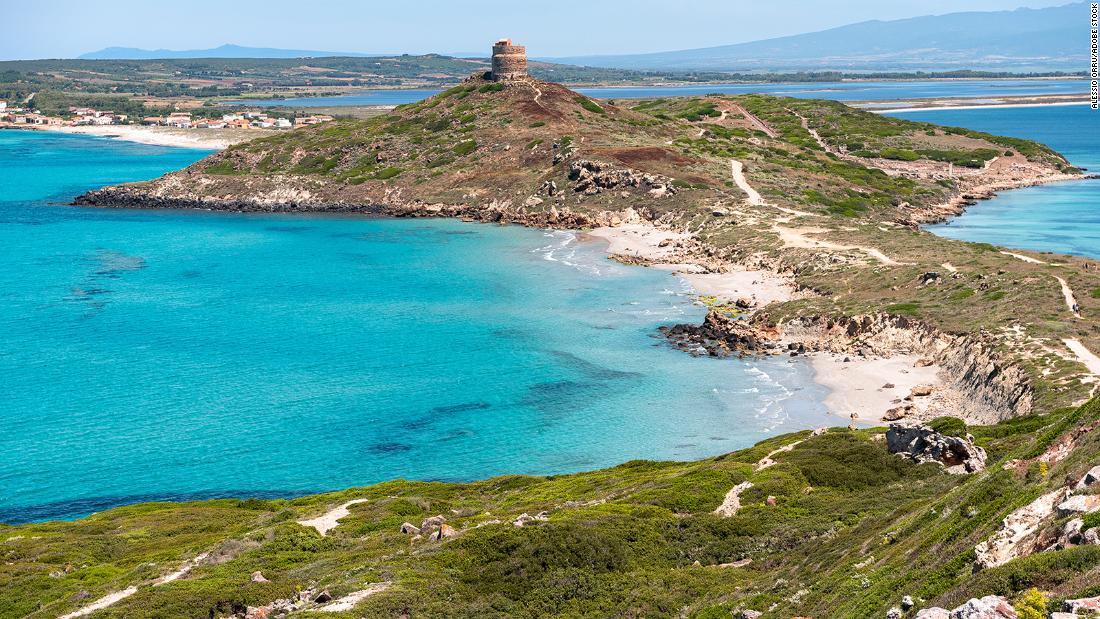(CNN) — Made up of over 1,000 kilometers of mostly oceanfront trails circling the island of Sardinia, the ‘Cammino 100 Torri’ — or 100 Towers Path — might not be Italy’s most famous hike, but it’s certainly of its most spectacular.
This epic round-trip journey, filled with blood-red sunsets, ancient architecture and stunning beaches, departs from the city of Cagliari on Sardinia’s southern-tip.
From there, eight different trails totaling 1,284 kilometers await, offering hikers the best Italy’s second-largest island region has to offer.
The full experience takes 45-60 days on average to complete. But for those short on time, it can easily be broken up into smaller trips.
The main highlights, as the path’s name suggests, are the 100 stone lookout towers that line Sardinia’s shores. Built over the 1500s and 1700s to defend against enemy incursions — pirates included — most have fallen into spooky ruin, though some have been transformed into lighthouses and private homes.
Once roamed by warriors, merchants, pilgrims, priests and raiders, the path rewards today’s hikers with the unique scents and scenery of the Mediterranean coast, with its purplish rocks, twisted beach tree branches and sand grains as thick as rice.
A spiritual journey
The 100 Towers Path takes hikers past fishermen villages, old chapels, castles, salt pans, abandoned caves, ponds and desert-like sand dunes, with views of Sardinia’s translucent waters never far away.
But for Nicola Melis, a local engineer who six years ago re-discovered the 100 Towers Path and has since circled the island alone four times, its allure goes behind just beautiful scenery.
“It’s more than just a path, it’s a spiritual pilgrimage inside your innermost self,” he tells CNN Travel. “if you do it solo it’s a physical and mental challenge. You conquer the deepest beauty of Sardinia through strain, and it’s rewarding.
“I love the toughest parts, like the steep uphill hike to Baunei’s tall cliffs, along the Ogliastra trail, with the greatest of views, because you solely rely on your own strength and endurance. You never forget your first hike here, it’s like your first car or girlfriend.”

On certain sections of the path, hikers can soothe their weary feet in the warm waters of the Mediterranean.
Nicola Melis
Melis says what pushed him to recover and promote the route was the discovery of a soldier’s pamphlet dating back to the 1500s that mapped the entire network of defensive towers. The soldier traveled the route on horseback, and then, spiritually changed by the long journey, decided to become a monk.
How to tackle it
If stretched out in a straight line, the 100 Towers Path is long enough to connect Italy’s Alps to its deepest southern lands. The farthest it deviates from the coast is just two kilometers inland.
Hikers are advised to start counter-clockwise from Cagliari, which allows them to dodge the intense Mistral northwest wind that would blow against them at the start of the hike, making it tougher.
Travelers can also join one of the association’s regular organized groups, usually made up of 20-60 hikers, or head out on their own journey for as many days as they want. It’s open year-round.
Hikers opting to do it alone are advised to evaluate their skills and fitness levels before setting out and bear in mind they could find themselves hiking under a scorching summer sun.
“You need to be fit, prepare to strain your muscles and avoid carrying a backpack that’s more than 10% of your body weight,” says Melis.
“You’ll find drinking water fountains and bars along the way, but sometimes they’re distant so study the journey well.”
Giants, angels and demons
Melis says there are four trails that have become particularly popular among hikers.
The shortest and easiest one, ideal for beginners, is the 62-kilometer Angels’ Path running from Cagliari up north towards the holiday seaside resort of Villasimius.
The hike starts off from one of the city’s oldest chapels, passing the first five towers in a ring-like direction. Called ‘the Devil’s Saddle’ it continues along baby powder and pebble stone beaches, silent inlets, grottos and coral reef seabeds.
The Sarcapos trail is next, running from Villasimius to Tertenia for 143 kilometers, mainly offering pure beach bliss along the pristine shores of Costa Rei. It takes about 5-7 days to finish this hike, which features a pond inhabited by pink flamingos, rocky hills, a river and the ruins of a Phoenician lost city, a temple and necropolis.
The scents of strawberry and mastic trees, myrtle and oak trees blend with the salty sea breeze.
The most challenging trail is the Ogliastra, on the eastern coast, suitable for experienced hikers. It runs for 144 kilometers and takes almost a whole week to complete, leading up Baunei’s steep mountains to mesmerizing sea crags such as Cala Gonone, crossing pine and juniper forests, natural rock arches, old sheepfolds, ancient coal merchants and donkey routes used by shepherds.
This one carries travelers into Sardinia’s untouched wilderness, offering breathtaking panoramas.

The 100 Towers Path is made up of eight trails that stretch 1,284 kilometers.
Nicola Melis
Archeology lovers will enjoy the pagan “Giants Trail” in the eastern Sinis Peninsula, another must-do section of the 100 Towers Path. Its name stems from the primitive nuraghe dwellings found in the area, dubbed “Giants,” which resemble miniature Stonehenges.
Hikers will wander through the lost Phoenician city of Tharros, its ruins dotting the landscape, and come across sacred pagan wells, an ancient Roman road and aqueduct.
Meanwhile, the Mines Trail, on the southwest coast, cuts through the tall white sand dunes of Piscinas, a huge desert-looking powder-white beach with one of the most translucent seas in the Mediterranean.
Abandoned mines and weird-shaped sea stacks such as the “sugar loaf” are the main stops.
“The 100 Towers Path connects 26 different coastal habitats, each with their peculiar vegetation and wildlife. You come across beach deserts, rocky granite hills and 40 protected oases with wild boars, sea turtles, cormorants, maritime pine forests,” says Melis.
Seafront convents and glamping

The towers that line the path were built over the 1500s and 1700s to defend against enemy incursions.
Alessio Orrù/Adobe Stock
Melis’s 100 Towers Path Association unites hikers, posts online calendars flagging group trips and offers a wide range of suggestions for accommodations, beach bars (‘chioschi’) and restaurants with special prices for hike participants.
Access to the path is free, but there are private guides for tailored short tours. The cost is around 150 euros ($150) per day for two people.
Hikers can chose from among 200 affiliated businesses for their daily pit stops.
Sardinia’s northern shores tend to be more touristy and crowded during summer, while the rest of the island, particularly the southwest coast, is more authentic and offbeat, allowing hikers to fully experience the thrill of the 100 Towers Path.
